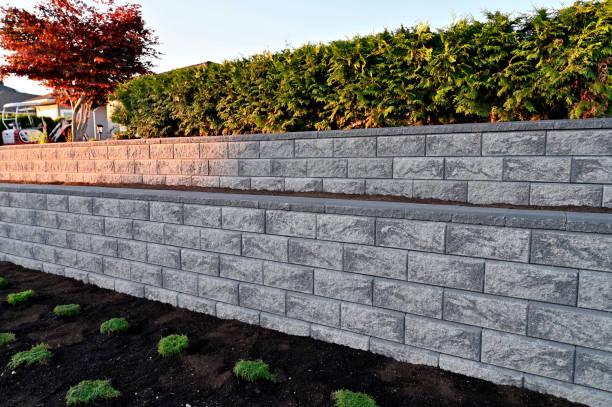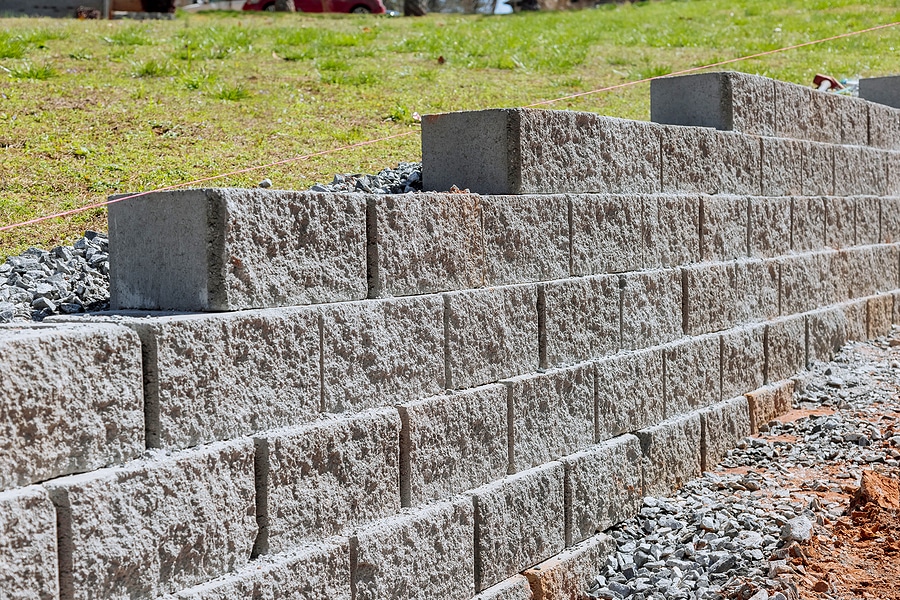Before and after with OKC Precision Retaining Walls
Before and after with OKC Precision Retaining Walls
Blog Article
Secret Factors To Consider for Building Effective Retaining Walls in Your Lawn
When you're thinking about developing a preserving wall in your yard, it's vital to consider a number of vital variables. The wall surface's function, the products you'll use, and the details dirt problems can all impact its performance and long life. You'll likewise need to browse neighborhood structure codes and plan for appropriate water drainage. Yet just how do you ensure your design not only satisfies these demands however additionally enhances your landscape? Let's explore the vital steps together.
Comprehending the Purpose of Your Retaining Wall
When you assume concerning building a keeping wall, consider its main purpose: supporting soil and preventing erosion. Retaining walls provide vital assistance for sloped landscapes, aiding to keep dirt integrity. You'll locate they're crucial in locations where water drainage may or else get rid of soil, leading to costly repair work and landscape damage.
By holding back planet, these walls develop degree surfaces for yards, patio areas, or paths. This not just boosts your lawn's appearances yet also promotes far better drainage, lowering water pooling in undesirable locations. If you're managing high inclines, a well-constructed retaining wall can prevent landslides, guaranteeing safety and security for you and your home.
Eventually, understanding the purpose of your retaining wall surface will certainly assist your style decisions and assist you produce a functional, sturdy framework that satisfies your needs. Take a minute to evaluate your landscape; it'll pay off in the lengthy run.
Selecting the Right Products
When picking materials for your retaining wall surface, you'll want to consider longevity, appearances, and cost. Each element plays a vital function in ensuring your wall surface stands the examination of time while looking wonderful and fitting your budget plan. Allow's discover just how to make the finest selections for your job.
Material Durability Aspects
Selecting the appropriate products is crucial for the long life and efficiency of your retaining wall surface, because their durability directly impacts the wall surface's ability to endure environmental stresses. Begin by considering your neighborhood environment; materials like concrete and rock resist wetness and temperature changes well. If you reside in an area susceptible to hefty rains, select materials with excellent drainage homes, like crushed rock or porous blocks, to avoid water accumulation.
Some products perform far better in details dirt types, so it's essential to match them as necessary. Selecting resilient materials guarantees your retaining wall stands strong, safeguarding your backyard for years to come.
Aesthetic Layout Selections
Sturdy products not only ensure your retaining wall surface's architectural integrity however also play a vital function in its visual allure. Do not forget regarding the wall surface's form-- curved walls can develop a softer appearance, while straight lines can feel a lot more organized. By very carefully choosing products that line up with your aesthetic vision, you'll boost your exterior space while ensuring your wall stands strong versus the elements.
Cost-Effectiveness Analysis
Choosing the best materials for your retaining wall surface isn't simply about looks; it's additionally important for your budget plan. When picking products, think about both in advance costs and lasting toughness.
Do not fail to remember to aspect in maintenance expenses. Some materials, like all-natural rock, can add beauty and call for much less maintenance, while others might require normal therapies
Inevitably, weigh the advantages and disadvantages of each option versus your budget and the wall surface's desired purpose. Investing carefully in products currently can avoid pricey problems in the future. Pick products that stabilize cost and efficiency successfully.
Evaluating Soil Problems and Drain
As you start your job, reviewing dirt problems and drainage is essential for the success of your retaining wall surface. Beginning by taking a look at the sort of dirt in your lawn. Sandy dirt drains well however does not have stability, while clay soil can keep dampness, causing press on your wall. Examine the soil's dampness content by excavating a small hole link and observing how swiftly it dries.
Following, assess the slope of your yard. If water normally flows toward your wall, you'll require to carry out a drainage service to avoid disintegration and stress accumulation. Consider mounting perforated pipes or gravel backfill behind the wall to promote drain.
Lastly, observe any type of nearby trees or greenery; their roots can influence dirt stability. By recognizing your soil problems and executing appropriate drain, you'll produce a solid foundation for your retaining wall surface that stands the test of time.
Conforming With Local Structure Codes
Prior to you begin developing your retaining wall, you require to research local regulations to guarantee compliance. It's vital to comprehend what allows you have to get, as this can save you from costly penalties or having to remodel your work. Taking these steps seriously will assist you build a secure and reliable framework.
Study Local Regulations
Comprehending neighborhood policies is crucial when planning your retaining wall surface task, specifically considering that developing codes can differ considerably by location. Look for guidelines on wall height, materials, drain systems, and architectural honesty. By doing your research upfront, you can guarantee your retaining wall fulfills all necessary codes and blends flawlessly into your backyard.
Obtain Essential Permits
When you have actually looked into neighborhood policies, the next step is to obtain the necessary licenses for your retaining wall surface project. They may need details plans or design assessments, especially for larger walls. Safeguarding the appropriate authorizations can conserve you from expensive fines or having to dismantle your wall surface later.

Planning the Style and Appearance
As you commence planning the design and aesthetic appeals of your retaining wall, take into consideration just how it will balance with the bordering landscape. Believe concerning the materials you'll utilize-- stone, brick, or concrete-- and exactly how they'll match your home's style and the natural environments in your yard. Choose colors and textures that blend effortlessly with existing functions like patios, paths, or gardens.
Next, imagine the wall's form and height. Bent walls can soften an inflexible landscape, while straight lines may share a more modern-day appearance. Do not fail to remember to integrate plants and plant around the wall for an all-natural touch; this can improve its allure and incorporate it into the setting.
Lastly, keep in mind capability. Your style useful reference must not only be aesthetically pleasing but likewise offer its objective successfully. By attentively preparing these elements, you'll produce a preserving wall that enhances your yard's beauty while fulfilling its architectural function.
Computing Height and Thickness Requirements
To develop a strong retaining wall, you require to properly determine its height and thickness demands based on the soil conditions and the elevation of the slope it will certainly sustain. Begin by reviewing the slope's angle and the sort of soil, as various soils exert varying amounts of pressure.
For walls over four feet high, take into consideration a thickness of at the very least 12 inches. If the wall is taller, raise the More hints thickness proportionally to keep security.
Following, compute the height of the wall by gauging the vertical distance it needs to maintain. For every foot of height, you must usually plan for a thickness of one-third of the wall surface's elevation.
Always bear in mind to make up added aspects like drain and backfill, which can influence your wall's layout. Proper calculations now ensure your retaining wall stands strong and lasts for many years to find.
Upkeep and Durability Considerations
While maintaining your retaining wall could seem like a low top priority, overlooking it can result in significant problems over time. Regular inspections are vital; look for cracks, bulges, or any type of indications of water damage. Addressing these troubles early can conserve you from costly fixings in the future.
Keep an eye on water drainage systems, too. Obstructed drains pipes can create water to develop, putting in pressure on your wall and compromising its stability. Clear debris and assurance appropriate flow to preserve durability.
You might also desire to review sealing your wall to protect it from moisture and weathering. Depending on the product, this may need reapplication every few years.
Last but not least, landscaping around your wall can sustain its stability. Stay clear of growing large trees nearby, as their origins can weaken the foundation. With positive maintenance, your retaining wall can serve you well for several years to find.

Frequently Asked Questions
Can I Build a Retaining Wall by Myself, or Should I Hire a Specialist?
You can certainly build a keeping wall on your own if you have the right devices and understanding. Working with a specialist guarantees it's done correctly, specifically for bigger or even more complicated structures. Consider your ability degree before determining.
What Are the A Lot Of Typical Blunders Made When Structure Retaining Walls?
When building retaining walls, you could neglect appropriate water drainage, skip making use of the appropriate materials, or overlook reinforcement. These usual mistakes can bring about structural failing, so take your time and strategy very carefully to stay clear of issues.
How Do I Know if My Retaining Wall Needs Reinforcement?
You'll recognize your retaining wall requires support if you discover splits, leaning, or bulging. Look for water pooling behind it or soil erosion near the base. Address these indicators quickly to stop more damages.
What Plant kingdom Are Suitable for Landscaping Around a Retaining Wall?
When landscaping around a preserving wall surface, think about using low-maintenance plants like succulents, decorative grasses, or sneaking ground covers - OKC Precision Retaining Walls. They'll grow in those problems and add beauty while protecting against dirt erosion around your wall
How Can I Prevent Erosion Around My Retaining Wall?
To avoid disintegration around your retaining wall, you can grow ground cover, use compost, and mount drainage systems. On a regular basis check for water accumulation and change landscaping to redirect overflow far from the wall surface.
Report this page